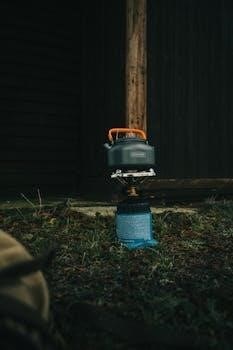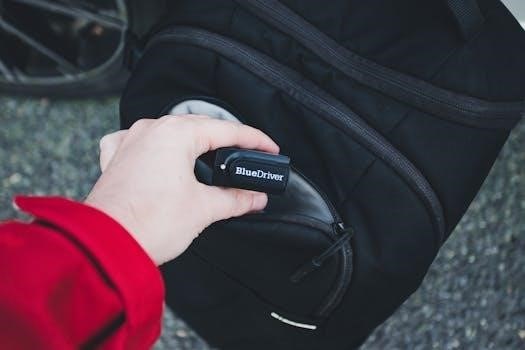Husqvarna 150BT Backpack Blower Owners Manual⁚ A Comprehensive Guide
Welcome! This guide offers a complete overview of the Husqvarna 150BT backpack blower․ We will navigate through its features, specifications, safety protocols, and maintenance tips․ Whether you’re a homeowner or professional landscaper, understanding this manual ensures optimal performance and longevity of your equipment․ Let’s begin exploring its capabilities!
The Husqvarna 150BT is a commercial-grade backpack blower designed for homeowners and professionals alike․ It falls into the popular 50cc mid-size range, boasting Husqvarna’s X-Torq engine, which provides power and efficiency․ Known for its ergonomic design, the 150BT features an adjustable harness and intuitive controls, ensuring operator comfort during extended use․ It is engineered to deliver a high blowing force, making it suitable for clearing leaves, debris, and other unwanted materials from lawns, pathways, and asphalt roads․
Its features include a powerful engine, high air volume and air speed․ The blower is designed to be lightweight and comfortable, enabling users to work for extended periods without undue strain․ Regular maintenance, as outlined in the operator’s manual, is crucial for maintaining optimal performance and extending the lifespan of the blower․ The manual provides detailed instructions on everything from fuel mixtures to spark plug maintenance, ensuring users have the knowledge to keep their 150BT running smoothly․
With proper care and maintenance, the Husqvarna 150BT offers a reliable solution for managing outdoor spaces effectively․
Downloading the Operator’s Manual (PDF)
Accessing the operator’s manual for your Husqvarna 150BT is essential for safe and effective operation․ Husqvarna provides these manuals online, free for download․ To obtain your PDF copy, visit the official Husqvarna website and navigate to the “Support” or “Manuals” section․ You can also search directly for “Husqvarna 150BT operator’s manual” using a search engine to find the official Husqvarna page or authorized dealer sites offering the download․
Once you locate the correct manual, simply click the download link to save the PDF to your device․ The PDF format allows for easy viewing on computers, tablets, and smartphones, and you can also print a hard copy for convenient reference while working․ The manual contains vital information, including safety instructions, operating procedures, maintenance schedules, and troubleshooting tips․
It’s crucial to review the manual thoroughly before using the blower to understand its features and ensure safe operation․ Keep the downloaded manual readily accessible for future reference, especially when performing maintenance or addressing any issues that may arise․ Having the manual ensures you can operate and maintain your 150BT effectively․
Understanding Safety Instructions

Before operating the Husqvarna 150BT backpack blower, carefully read and understand all safety instructions outlined in the operator’s manual․ Safety is paramount to prevent personal injury and equipment damage․ Always wear appropriate personal protective equipment (PPE), including eye protection, hearing protection, and sturdy footwear․ Avoid loose clothing or jewelry that could get caught in the blower’s moving parts․
Be aware of your surroundings and maintain a safe distance from bystanders, especially children and pets․ Never point the blower nozzle towards people or animals․ Operate the blower in well-ventilated areas to avoid inhaling exhaust fumes․ Refuel the blower in a safe location away from open flames or sparks, and never while the engine is running․
Inspect the blower before each use to ensure all components are in good working order․ Check for loose screws, damaged parts, and fuel leaks․ If any issues are detected, do not operate the blower until repairs are made․ Familiarize yourself with the blower’s controls and emergency stop procedures․ Following these safety guidelines will help ensure a safe and productive operating experience with your Husqvarna 150BT․
Operating Instructions

To operate the Husqvarna 150BT backpack blower effectively, begin by ensuring the unit is properly assembled and fueled according to the manual’s instructions․ Before starting, inspect all components for damage and confirm that the air filter is clean and the spark plug is securely connected․ Put on all necessary safety gear including eye and ear protection․
When starting, place the blower on a flat surface and engage the choke if the engine is cold․ Use the starter cord to ignite the engine, and gradually disengage the choke as the engine warms up․ Adjust the throttle to control the blowing force․ Use a sweeping motion to efficiently clear leaves and debris from the desired area, being mindful of bystanders and obstacles․
Always maintain a firm grip on the blower and avoid overreaching․ After use, allow the engine to cool before storing․ Clean the blower thoroughly, removing any debris from the fan and housing․ Store the blower in a dry, safe place, away from flammable materials․ Regular adherence to these operating procedures will ensure the Husqvarna 150BT performs optimally and remains in good condition․
Technical Data⁚ Engine Specifications
The Husqvarna 150BT backpack blower is equipped with a robust 50․2cc, 2-cycle X-Torq engine, designed for optimal power and fuel efficiency․ The engine features a cylinder displacement of 3․06 cubic inches․ Its idle speed is typically around 2700 RPM, ensuring smooth operation and reduced noise during periods of low activity․ The blower incorporates a catalytic converter to minimize harmful emissions․
The ignition system uses a spark plug with an electrode gap of 0․02 inches (0․5 mm)․ The recommended spark plug torque is approximately 7․4 ft-lb (10 Nm)․ The fuel tank has a capacity of 1․26 US Pints (0․6 liters), allowing for extended operation without frequent refueling․ The blower’s weight, excluding fuel, is approximately 22․5 lbs (10․2 kg), providing a balance between power and portability․
These engine specifications highlight the 150BT’s design for commercial-grade performance․ The X-Torq technology ensures that the engine delivers ample power while maintaining fuel efficiency and reducing emissions․ Regular maintenance and adherence to recommended fuel mixtures will prolong the engine’s life and maintain its performance․

Fuel and Lubrication System
The Husqvarna 150BT backpack blower operates on a two-stroke engine, requiring a precise mixture of gasoline and two-stroke oil for optimal performance and longevity․ The recommended fuel mixture is typically a 50⁚1 ratio, meaning 50 parts of gasoline to 1 part of high-quality two-stroke oil․ Always use fresh, unleaded gasoline with a minimum octane rating of 89 (AKI) or 95 (RON)․
For lubrication, Husqvarna recommends using their own brand of two-stroke oil, specifically designed for air-cooled engines․ This oil contains additives that help to reduce wear, prevent carbon buildup, and ensure smooth engine operation․ Alternatively, a high-quality, JASO FD or ISO EGD certified two-stroke oil can be used․
When mixing fuel, always do so in a clean, approved fuel container․ Start by adding half of the gasoline, then add the correct amount of two-stroke oil, and finally, add the remaining gasoline․ Secure the container cap and shake vigorously to ensure thorough mixing․ Never mix fuel directly in the blower’s fuel tank, and always use fresh fuel mixtures, as they can degrade over time․
Maintenance Tasks
Regular maintenance is crucial for ensuring the Husqvarna 150BT backpack blower operates efficiently and reliably․ Start by cleaning the air filter regularly, typically after every 25 hours of use, or more frequently in dusty conditions․ Remove the air filter cover, take out the filter, and gently tap it to remove loose debris․ If heavily soiled, wash it with warm, soapy water, rinse thoroughly, and allow it to dry completely before reinstalling․
Inspect the spark plug periodically and replace it if it shows signs of wear or fouling․ The correct spark plug type is essential for proper engine operation․ Also, check the fuel filter regularly and replace it if it becomes clogged․ A clogged fuel filter can restrict fuel flow and cause engine starting or performance problems;
Additionally, inspect the blower fan and housing for any debris or damage․ Clean the cooling fins on the engine cylinder to prevent overheating․ Periodically check and tighten any loose screws or bolts․ Finally, at the end of the season, drain the fuel tank and run the engine until it stops to prevent fuel degradation during storage․
Troubleshooting Common Issues
Encountering issues with your Husqvarna 150BT? Let’s troubleshoot some common problems․ If the blower doesn’t start, first ensure the fuel tank has fresh fuel and the spark plug is clean and properly connected․ Check if the air filter is clean, as a clogged filter can prevent the engine from starting․ If the engine starts but runs poorly, examine the carburetor for any blockages or damage․ Consider adjusting the carburetor settings according to the manual’s instructions․
If the blower lacks power, ensure the spark arrestor is clean, as a clogged spark arrestor can restrict exhaust flow․ Also, inspect the fuel lines for any cracks or leaks․ If the blower vibrates excessively, check the fan for damage or imbalance․ A damaged fan can cause significant vibration and should be replaced․
For any persistent or complex issues, consult a qualified Husqvarna service technician․ Always refer to the operator’s manual for specific troubleshooting steps and safety precautions․ Remember to disconnect the spark plug before performing any maintenance or repairs․
Spare Parts and Diagrams
Maintaining your Husqvarna 150BT requires access to the correct spare parts․ Identifying the right component is crucial for effective repairs․ Consult the parts diagram within the operator’s manual for a detailed visual representation of each part and its location within the blower assembly․ The parts diagram typically includes exploded views, making it easier to identify individual components and their relationship to each other․
Commonly replaced parts include air filters, fuel filters, spark plugs, and blower fans․ Part numbers are usually listed alongside each component in the diagram; When ordering spare parts, always use the correct part number to ensure compatibility․ You can find genuine Husqvarna parts at authorized Husqvarna dealers or through online retailers․ Using genuine parts ensures the quality and performance of your blower․
The parts diagram also aids in understanding the assembly and disassembly process․ Before attempting any repairs, carefully study the diagram to avoid damaging other components․ Remember to consult the operator’s manual for specific instructions and safety precautions․
Where to Find Additional Support and Manuals
If you need further assistance or have misplaced your physical manual, several resources are available․ The official Husqvarna website is the primary source for operator’s manuals, illustrated parts lists, and other helpful documentation․ Look for the “Support” or “Service” section on the website to find manuals specific to your 150BT model․ These manuals are often available in PDF format for easy downloading and printing․

Authorized Husqvarna dealers are another valuable source of support․ They can provide expert advice, troubleshooting assistance, and information on spare parts and accessories․ Many dealers also offer repair services․ Online forums and communities dedicated to Husqvarna products can provide peer-to-peer support, tips, and solutions to common problems․ Be cautious when following advice from unofficial sources․
Remember to have your blower’s model number and serial number readily available when seeking support․ This information helps ensure you receive accurate and relevant assistance․ Always prioritize official Husqvarna resources for the most reliable information․
Using Husqvarna Premixed Alkylate Fuel
For optimal performance and extended engine life, consider using Husqvarna’s premixed alkylate fuel․ This specialized fuel offers several advantages over standard gasoline mixtures․ Alkylate fuel contains fewer harmful chemicals, resulting in cleaner combustion and reduced exhaust emissions․ This is beneficial for both the environment and the operator’s health․
Husqvarna’s premixed fuel is also designed to minimize residue buildup in the engine․ This helps prevent clogs and ensures consistent performance over time․ The premixed formula eliminates the guesswork of mixing fuel and oil, ensuring the correct ratio for your 150BT blower․ Using the recommended fuel can also improve the blower’s starting reliability and overall efficiency․
When using Husqvarna premixed alkylate fuel, follow the instructions on the container․ Store the fuel in a cool, dry place away from direct sunlight and heat sources․ Always use a clean fuel container to prevent contamination․ By choosing Husqvarna premixed fuel, you can protect your investment and enjoy years of reliable service from your 150BT backpack blower․


